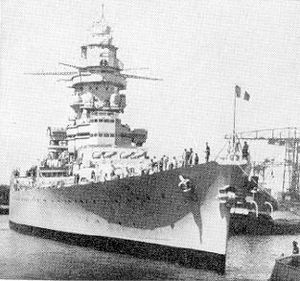French battleship Strasbourg

French Battleship Strasbourg
|
|
| History | |
|---|---|
|
|
|
| Namesake: | City of Strasbourg |
| Laid down: | November 1934 |
| Launched: | 12 December 1936 |
| Homeport: | Brest, till April 1940, Mers-el-Kebir in May–July 1940,Toulon after the July 6, 1940 |
| Fate: | Scuttled on 27 November 1942, sunk in 1944 |
| Status: | Sold for scrap in 1955 |
| General characteristics | |
| Class and type: | Dunkerque-class battleship |
| Displacement: | 27,300 long tons (27,700 t) |
| Length: | 215.1 m (706 ft) |
| Beam: | 31.1 m (102 ft) |
| Draught: | 8.7 m (29 ft) |
| Propulsion: |
|
| Speed: | 30.4 knots (56.3 km/h; 35.0 mph) |
| Range: | 13,900 km (7,500 nmi; 8,600 mi) |
| Complement: | 1381 |
| Armament: |
|
| Armour: |
|
| Aircraft carried: |
|
Strasbourg was the second and last battleship of the Dunkerque class built for the French Navy before World War II. She was slightly more heavily armoured than her sister ship Dunkerque.
In 1922, the Washington Naval Treaty imposed a ten-year moratorium on the construction of new battleships. France was allowed to replace two old battleships after 1927 for a total of 70,000 tons.
In 1925, the first Italian Trento-class cruiser was laid down, and launched the following year; these ships could threaten French sea lanes between metropolitan France and colonial holdings in North Africa. In response, Vice Admiral Henri Salaun of the French Admiralty began discussing counters in 1926 and 1927. They considered a 17,500 ton design which would allow for four ships under the treaty limit. They would have two quadruple 305 mm (12-inches) turrets forward. The use of quadruple-gunned turrets had been planned for the cancelled Normandie and Lyon-class battleships, while the all-forward configuration was inspired by the British Nelson class. Speed would have been 34–35 knots, with armour to resist 203 mm shells. However, these ships were not ordered as they could not withstand old Italian battleships.
The 17,500 ton design was followed by new studies for a 37,000 ton battlecruiser in 1927–1928. A trial displacement of 37,000 tons was equivalent to a standard displacement of 32–33,000 tons, which was close to the treaty limit for battleships. At least two draft designs were made, showing an enlarged Suffren-class cruiser with a 254m long hull with a 30.5m beam and two raked funnels. The main armament's fire control director was atop a tripod foremast. Armament was three quadruple 305 mm turrets (two fore and one aft), eight single 90 mm Mle 1926 HA guns, twelve 37 mm Mle 1925 single AA mountings, and triple torpedo tubes. The armour belt would have a 220–280mm thickness. A hangar was behind the bridge structure with two catapults abeam the second funnel. Power would have been from two groups of boilers and turbines, as on the Duquesne classes, although with 12 rather than 8 Guyot-du-Temple boilers for 180,000 hp and 33 knots.
...
Wikipedia
